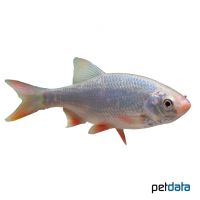Common Rudd (Scardinius erythrophthalmus)
| Common Rudd Scardinius erythrophthalmus | |
|---|---|
| Name | Common Rudd |
| Name Lat. | Scardinius erythrophthalmus |
| Family | Minnows |
| Family lat. | Leuciscidae |
| Order | Carps |
| Order lat. | Cypriniformes |
| Origin | Europe, Asia |
| Habitat | Rivers, oxbow lakes |
| Diet | Omnivore |
| pH | 6.5-7.5 |
| Behavior | Peaceful |
| Keeping | Group |
| Care Level | Easy |
| Reproduction | Egg scatterer |
| Breeding | Moderately difficult |
| Life Span | 15-20 years |
| Protection | No |
| Metric Units | |
| Size | 20-30 cm |
| Temperature | 4-22 °C |
| Hardness | 10-20 °dH |
| Aquarium | Pond |
| US Units | |
| Size | 8"-12" |
| Temperature | 39-72 °F |
| Hardness | 178-356 ppm |
| Aquarium | Pond |
Distribution and habitat
The range of the rudd extends from Western Europe, north of the Pyrenees and Alps, to the Aral Sea and they have produced several subspecies. They live in shoals in stagnant and slow-flowing waters, such as lakes, ponds and rivers with muddy-sandy bottoms and dense underwater vegetation, where they like to stay near the water surface.
Maintenance
They require sufficiently large ponds, which should be furnished with pond, floating and oxygenating underwater plants (milfoil, waterweed, hornwort, etc.), large river pebbles and a substrate of round-grained gravel and sand, and provide free swimming space.
No ammonia, ammonium and nitrite should be detectable in the water, and the nitrate level should not exceed 100 mg/l. To ensure the water quality and oxygen content, a filter adapted to the water volume should not be missing.
Diet
They feed mainly on algae and soft plant parts. The food supply consists mainly of commercially available special dry food for pond fish (flakes, sticks, granules) with low protein content (below 30%). In addition, they require plant food, such as aquatic plants (Rizzia flutians etc.) or over-broken leaves (e.g. dandelion) or dry food with high plant content (spirulina). Only occasionally live food should be offered, such as daphnia, tubifex or mosquito larvae, which are also accepted without problems in frozen form
Regular and varied feeding promotes health and increases resistance.
Behaviour and compatibility
They are calm, peaceful and sociable fish that do not exhibit any aggressive or incompatible behaviors. At least 5, but preferably many more rudd should be kept together. They can be socialized well with other peaceful pond fish, such as gudgeon, orfe, etc
Basically, only compatible fish species with similar demands on water condition and water temperature should be socialized.
Reproduction and breeding
The sexes are difficult to distinguish. At spawning time, the males have a spawning rash and the females appear rounder.
Females spawn in shoals between April and June, at water temperatures of 18-20 °C, in shallow, densely vegetated shorelines. The sticky eggs adhere to aquatic plants and roots. After 3-10 days, the larvae hatch and attach to aquatic plants until their yolk sac is exhausted. The young fish grow very slowly and are sexually mature after 3-4 years. Life expectancy can be up to 20 years.
Important
Rudd are good for controlling algae in the pond, they also eat filamentous algae, however they can also decimate aquatic plant life.
Rudd can easily be confused with roach. In the wild, mixed spawning shoals occasionally occur. This results in crossbreeding, which is difficult to determine
If they are overwintered in the pond, sufficient depth and oxygen supply (filter, oxygen dispenser, ice free holder) must be ensured.
At temperatures below 8-10 °C the metabolism of the fish slows down and food is no longer accepted, feeding must be stopped accordingly. If the temperature drops further, they hibernate near the bottom. In spring, with rising temperatures, feeding can slowly be resumed. Feeding may also be necessary during prolonged warm periods in winter.
The well-being of the fish should be monitored regularly. A regular partial water change, according to the pond size is recommended, even if the pollutant load has not yet reached the upper limit. Sudden changes in water quality should be avoided. Newly introduced fish must be accustomed slowly to the water in the pond
Further literature can be found in your pet store.
References
Text: Werner Winter; Image: petdata
Source: BMELV (1998): Tierschutzgutachten - Haltung von Zierfischen (Süßwasser); RIEHL & BAENSCH (2006): Aquarien Atlas Bd. 1, Mergus Verlag; ENGELMANN (2005): Zootierhaltung - Tiere in menschlicher Obhut: Fische; Harri Deutsch Verlag
- Gemäß § 21 Abs. 5 Tierschutzgesetz idgF
